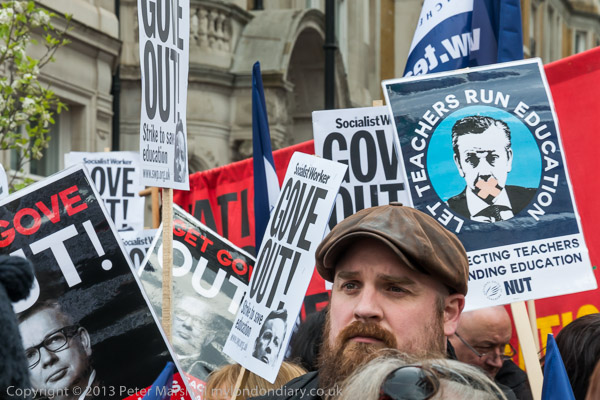
Education is something almost everyone thinks they are an expert on. After all, we all (or almost all) went to at least one school. Those who end up running education ministries obviously did very well at it. So it’s hard for them to realise what it is like for those who don’t succeed. It’s also very hard for those who haven’t experience it to understand what it is like to be on the other side of the experience, as a teacher, particularly a teacher in very different schools to those that most government ministers attended. Though Michael Gove wasn’t one of the Etonians; an adopted child (his birth mother an impoverished student in Edinburgh), he did very well at the state primary he attended in Aberdeen, well enough to pass the scholarship to one of Scotland’s best private schools, and later to get a scholarship to meet the costs, and then on to Oxford – in the days of student grants and before students paid fees. His was hardly a typical experience of our state education system.
Back in my own twenties and thirties, I spent almost ten years teaching in one of the country’s largest comprehensive schools. People used to think teaching was an easy job, but I saw the toll it took on some of my colleagues, several who had to leave the profession after breakdowns and felt the stress myself. Actual teaching – ‘contact time’ – was around 25 hours a week, but with meetings, marking, lesson preparation and record-keeping I was putting in over 60 hours a week during term-time.
Although we didn’t have Ofsted then, there were various inspections and observations. One man came into my lesson armed with some kind of form for recording what teachers actually did; at the end of the lesson – a science practical class for 12-year-olds – I asked him about it. His reply was that he simply could not keep up with me, and supervising 15 pairs of students carrying out various practical tasks was often physically as well as mentally demanding.
After ten years I was feeling exhausted, and took a pay cut to move to a former grammar school that was in the final transition to a sixth-form college. It had the advantage too of being closer to home – a couple of miles on a bike – so I could spend a little more time with my young family (see my first ever web site.) For a few years things were easier, but soon things began to ratchet up, particularly with the greater demands for highly detailed lesson plans, the national curriculum and in 1992, Ofsted. Teacher morale became very low, and staff turnover – with many colleagues leaving the profession or moving to the private sector – reached an all time high. Even in a relatively easy outer London suburban area (although there were particular local problems with a bullying principal), one year around a third of the staff changed. I was relieved when I began to earn enough outside of teaching from my photography related activities to go part-time, and then to stop teaching altogether.
The whole trend of education (and other) policies in the UK over the past 20 or so years has been driven by successive governments taking away powers from local authorities and both centralising control and handing some out to non-elected private bodies. The result is chaos and competition in a system which needs cooperation and organisation. Students suffer, and so even more do teachers. And Gove wants to make things even worse.
I’m still a member of the NUT – though a retired one – as well as of the NUJ, and have considerable sympathy for the teachers who were striking and marching though London.
The day started off rather dull, with just the occasional spot of rain – just enough to make it necessary to keep a watch on the lens filters for a drop and for the occasional image to be ruined when I missed this.
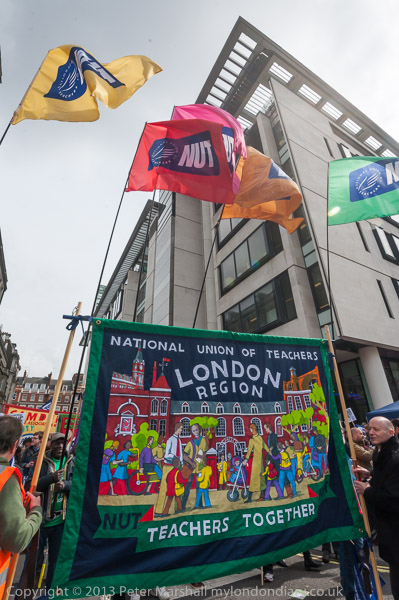
Those tall flags were something of a problem when close to the protest, but I suppose they showed up well from a distance – as when the march was entering Trafalgar Square, where it was also hit by a really heavy shower.
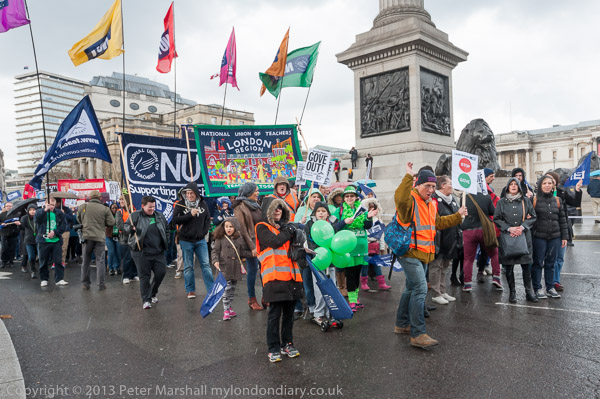

I’d thought of some obvious key points at which to photograph the march, apart from the start, always a good place as people are crowded together and relatively static. It was actually a little too crowded on this occasion, making it very difficult, particularly with the banners in the way, to move around. The march gathered in a fairly narrow street and it was very full.
The first of these points was Broadcasting House, particularly since the teachers (like almost all other protesters) feel they are not given fair treatment. In the weeks leading up to the strike the BBC had largely ignored the case being made by the teachers and given rather more prominence to the governments view that this was an unnecessary strike, and had also very much minimised the effect it would have in closing schools. In most parts of London a very high proportion of schools were affected – either fully closed or with large numbers of pupils told not to attend, and the same seems to have been true across the country.
On the day, the BBC did give a lot of coverage to the strike, and NUT General Secretary Christine Blower was interviewed on the Today programme, though there were some slightly curious aspects to some of their comments. Their report of the London march as by ‘over 1500’ teachers is as usual significantly lower than most estimates.
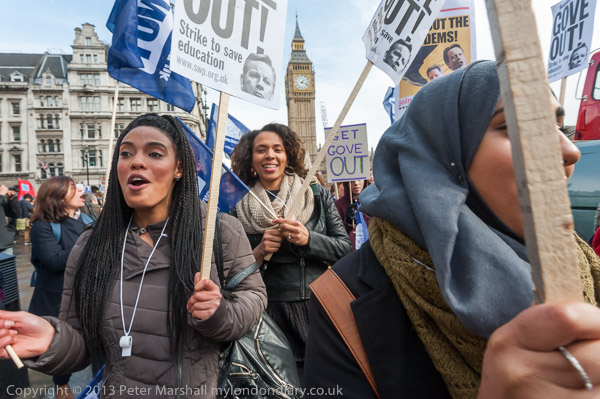
Other key points were those that say ‘London’ strongly, such as Piccadilly Circus and Trafalgar Square, and I didn’t really do to well as either of these, partly because of the heavy shower. I paused briefly at 10 Downing St to record some of the shouting and gesturing at that point, but the main attraction for almost all of the photographers was of course Big Ben and the Houses of Parliament.
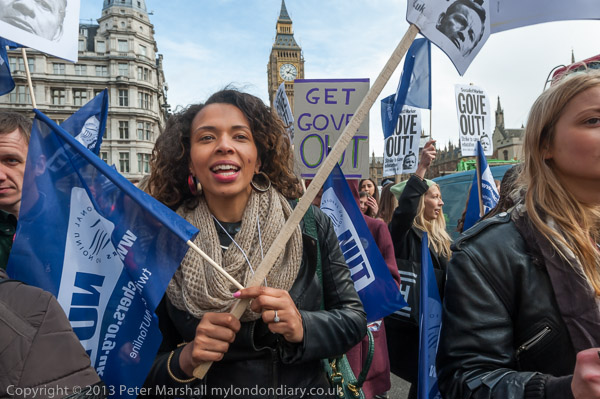
There are quite a few more pictures taken with that clock in the background in Teachers March on NUT Strike Day and a couple are not bad, but perhaps not quite as strong as I would have liked. You need a little luck working in complex situations like this, with protesters moving, people holding placards (and often obscuring the background) and passing traffic as police kept the road open, and today it didn’t quite happen.
______________________________________________________
My London Diary : Buildings of London : River Lea/Lee Valley : London’s Industrial Heritage
All photographs on this and my other sites, unless otherwise stated, are taken by and copyright of Peter Marshall, and are available for reproduction or can be bought as prints.
To order prints or reproduce images
________________________________________________________